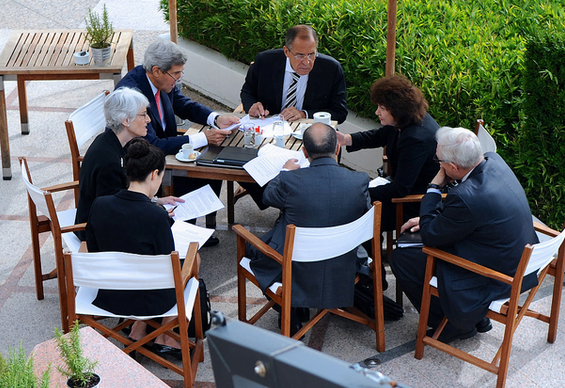The head of the UN team overseeing the destruction of Syria’s chemical weapons, Sigrid Kaag, gave a rare interview last night to PBS. On Monday the first batch of Syria’s chemical stockpiles was taken from inside Syria, to the port of Latakia, destined for a US naval ship where it will be destroyed.
GWEN IFILL: How many countries are we talking about involved in this?
SIGRID KAAG: Oh, it’s quite a huge and unique international effort.
If you look at just the sheer donation side, in terms of logistics or other physical items that are needed for packing, loading containers, a lot of European countries, United States, Russian Federation, People’s Republic of China, Denmark and Norway in terms of the vessels, but a lot of other countries have donated financing as well. And, of course, when we’re looking at the destruction side that takes place, both of the U.S. vessel the Cape Ray, but also the commercial destruction of the chemical effluents, many more countries are involved.
So, it is unique. It is also unprecedented. And, as you just highlighted, it is not without challenge.
GWEN IFILL: You mentioned a moment ago about the cooperation or the needed cooperation of the Syrian government itself. And earlier today, you described it as constructive. Can you elaborate on that?
SIGRID KAAG: Yes, constructive is a term we have used from the beginning.
The secretary-general has often referenced that as well. And it’s basically a reflection of how the [cooperation] has been going from the day the joint mission was established and the mandate was given also by the Security Council. At all levels, we work at a technical level, at a more political level, my level, looking at problems, advancing solutions, but always making sure that we from a joint mission perspective keep our eye on the ball, which is the very timely, safe and secure elimination of the chemical weapons program.
It requires a lot of investments by the Syrian authorities, staff time. They need to secure the roots, they need to make sure the convoys do take off, packaging, and obviously readiness for onward transportation. Yesterday, in Latakia, for instance, we know — my team was there, of course. We saw that the whole area had to be secured.
The port authorities are involved. Many, many other national staff members in Syria are also engaged in this effort. So cooperation is measured in many different ways. It’s very practical, very tangible.
The isolation and destruction of Syria’s chemical weapons is happening because the international community is fully united behind this goal (that unity was manifest in Security Council resolution 2118, which passed unanimously in September). And because the international community is united, the Syrian government is complying with the dictates of that resolution.
The destruction of Syria’s chemical weapons is a success of the UN and international system. It demonstrates that when the international community is united there can be real progress on Syria.
The next big test of international unity on Syria will come on January 22, when representatives from over 30 countries, the Syrian government and rebel leaders are scheduled to attend a long-sought peace conference in Montreux, Switzerland. If a consensus can be reached by the key international players about the political future of Syria, then 2014 will be the year that Syria turns the corner. If international unity proves elusive, we can expect more death and destruction.
We now know progress on Syria is possible, but it requires unity from the key international players.
